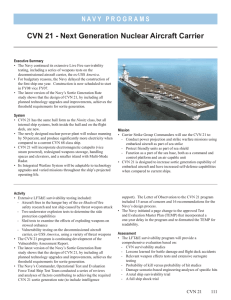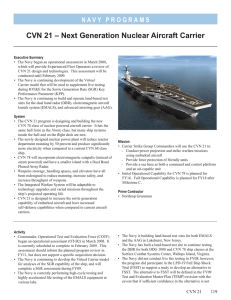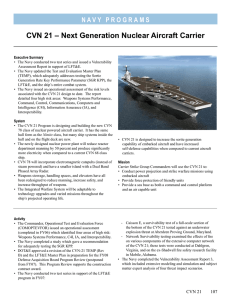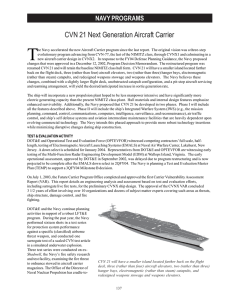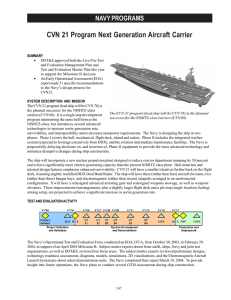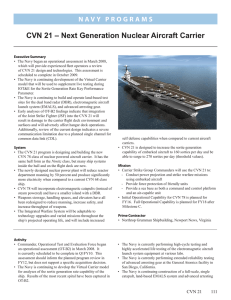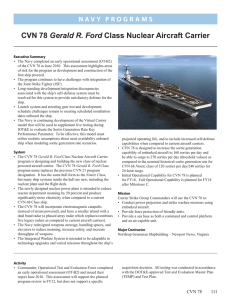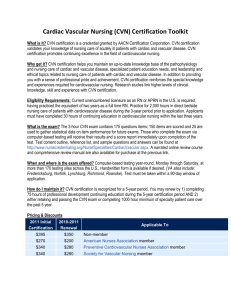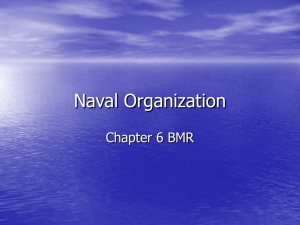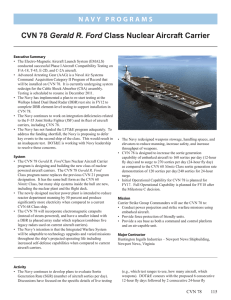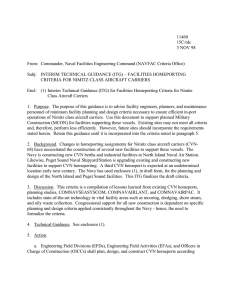CVN 21 - Next Generation Nuclear Aircraft Carrier
advertisement
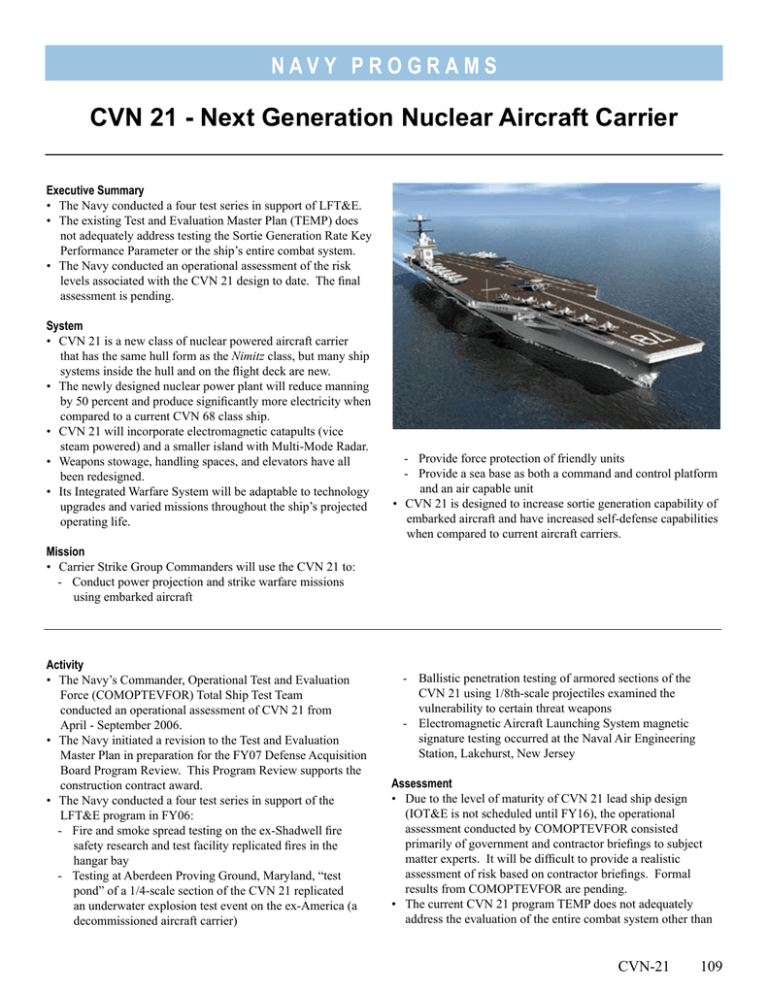
Navy P RO G R A M S CVN 21 - Next Generation Nuclear Aircraft Carrier Executive Summary • The Navy conducted a four test series in support of LFT&E. • The existing Test and Evaluation Master Plan (TEMP) does not adequately address testing the Sortie Generation Rate Key Performance Parameter or the ship’s entire combat system. • The Navy conducted an operational assessment of the risk levels associated with the CVN 21 design to date. The final assessment is pending. System • CVN 21 is a new class of nuclear powered aircraft carrier that has the same hull form as the Nimitz class, but many ship systems inside the hull and on the flight deck are new. • The newly designed nuclear power plant will reduce manning by 50 percent and produce significantly more electricity when compared to a current CVN 68 class ship. • CVN 21 will incorporate electromagnetic catapults (vice steam powered) and a smaller island with Multi-Mode Radar. • Weapons stowage, handling spaces, and elevators have all been redesigned. • Its Integrated Warfare System will be adaptable to technology upgrades and varied missions throughout the ship’s projected operating life. - Provide force protection of friendly units - Provide a sea base as both a command and control platform and an air capable unit • CVN 21 is designed to increase sortie generation capability of embarked aircraft and have increased self-defense capabilities when compared to current aircraft carriers. Mission • Carrier Strike Group Commanders will use the CVN 21 to: - Conduct power projection and strike warfare missions using embarked aircraft Activity • The Navy’s Commander, Operational Test and Evaluation Force (COMOPTEVFOR) Total Ship Test Team conducted an operational assessment of CVN 21 from April - September 2006. • The Navy initiated a revision to the Test and Evaluation Master Plan in preparation for the FY07 Defense Acquisition Board Program Review. This Program Review supports the construction contract award. • The Navy conducted a four test series in support of the LFT&E program in FY06: - Fire and smoke spread testing on the ex-Shadwell fire safety research and test facility replicated fires in the hangar bay - Testing at Aberdeen Proving Ground, Maryland, “test pond” of a 1/4-scale section of the CVN 21 replicated an underwater explosion test event on the ex-America (a decommissioned aircraft carrier) - Ballistic penetration testing of armored sections of the CVN 21 using 1/8th-scale projectiles examined the vulnerability to certain threat weapons - Electromagnetic Aircraft Launching System magnetic signature testing occurred at the Naval Air Engineering Station, Lakehurst, New Jersey Assessment • Due to the level of maturity of CVN 21 lead ship design (IOT&E is not scheduled until FY16), the operational assessment conducted by COMOPTEVFOR consisted primarily of government and contractor briefings to subject matter experts. It will be difficult to provide a realistic assessment of risk based on contractor briefings. Formal results from COMOPTEVFOR are pending. • The current CVN 21 program TEMP does not adequately address the evaluation of the entire combat system other than CVN-21 109 Navy P RO G R A M S what is being evaluated in the Navy’s Capstone Ship Self Defense Air Warfare TEMP. Additionally, a Threat D target is required for adequate evaluation of defense against cruise missiles, yet the Navy lacks an adequate Threat D target. • The current TEMP does not adequately address the evaluation of the Sortie Generation Rate Key Performance Parameter. A modeling and simulation effort that currently centers around six different federated models has potential to reduce risk, but does not mitigate the need to actually exercise and test the Sortie Generation Rate Key Performance Parameter. • The comprehensive CVN 21 LFT&E will be based on CVN survivability studies, lessons learned from battle damage and flight deck accidents, relevant weapon effects tests, extensive surrogate testing, probability of kill versus probability of hit studies, damage scenario-based engineering analyses of specific hits, a total ship survivability trial, and a full ship shock trial. 110 CVN-21 • Significant progress continues on the vulnerability assessment report based on the Navy’s extensive modeling and simulation analyses comparing data to the ex-America sinking exercise during the summer of 2005. Recommendation • Status of Previous Recommendations. FY05 #1: DOT&E recommended that the CVN 21 design program thoroughly evaluate the recommendations in the COMOPTEVFOR Letter of Observation in the design process. This remains a valid recommendation. • FY06 Recommendations. The Navy should: 1. Incorporate an adequate evaluation of the entire combat system in the next TEMP update. 2. Develop an adequate Threat D target. 3. Include an adequate Sortie Generation Rate test in the next TEMP update.
